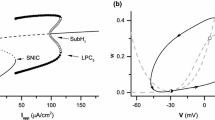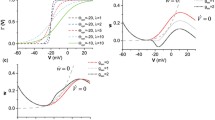Abstract
In this paper, we describe an analysis of the nonlinear dynamical phenomenon associated with a silicon neuron. Our silicon neuron in Very Large Scale Integration (VLSI) integrates Hodgkin–Huxley (HH) model formalism, including the membrane voltage dependency of temporal dynamics. Analysis of the bifurcation conditions allow us to identify different regimes in the parameter space that are desirable for biasing our silicon neuron. This approach of studying bifurcations is useful because it is believed that computational properties of neurons are based on the bifurcations exhibited by these dynamical systems in response to some changing stimulus. We describe numerical simulations of the Hopf bifurcation which is characteristic of class 2 excitability in the HH model. We also show experimental measurements of an observed phenomenon in biological neurons and termed excitation block, firing rate and effect of current impulses. Hence, by showing that this silicon neuron has similar bifurcations to a certain class of biological neurons, we can claim that the silicon neuron can also perform similar computations.







Similar content being viewed by others
References
Izhikevich EM (2000) Neural excitability, spiking and bursting. IJBC 10:1171–1266
Rinzel J, Ermentrout GB (1989) Analysis of Neural excitability and oscillations. In: Koch C, Segev I (eds) Methods in neural engineering, Cambridge
Chua LO, Roska T, Kozek et al. (1996) CNN universal chips crank up the computing power. IEEE circuits devices magazine, vol 12, pp 18–28
Hodgkin AL, Huxley AF (1952) A quantitative description of membrane current and its application to conduction and excitation nerve. J Physiol 117:500–544
Simoni MF, Cymbalyuk GS, Sorensen ME et al (2004) A multiconductance silicon neuron with biologically matched dynamics. IEEE Trans Biomed Eng 51:342–354
Hodgkin AL (1948) The local electric changes associated with repetitive action in a non medullated axon. J Physiol 107:165–181
Hassard B (1978) Bifurcation of periodic solutions of the Hodgkin-Huxley model of the squid giant axon. J Theor Biol 71:401–420
Hassard B, Kazarinoff ND, Wan YH (1981) Theory and applications of Hopf bifurcation. Cambridge University Press, Cambridge
Kohno T, Aihara K (2005) A MOSFET-Based Model of a Class 2 nerve membrane. IEEE Trans Neural Networks 16(3):754–773
Basu A, Petre C, Hasler P (2010) Dynamics and bifurcations in a silicon neuron. IEEE Trans Biomed Circuits Syst 4:320–328
Grassia F, Buhry L, Lévi T et al (2011) Tunable neuromimetic integrated system for emulating cortical neuron models. Front Neurosci 5:134. doi:10.3389/fnins.2011.00134
Saïghi S, Bornat Y, Tomas J et al (2010) A library of analog operators based on the Hodgkin-Huxley formalism for the design of tunable and real-time silicon neurons. IEEE Trans Biomed Circuits Syst 5:3–19
Hansel D, Mato G, Meunier C (1993) Phase dynamics for weakly coupled Hodgkin–Huxley neurons. Europhys Lett 23:367–372
Acknowledgments
This project was partly supported by funding under the Seventh Research Framework Program of the European Union FP7-PEOPLE-ITN-2008 under the Grant no 237955 (FACETS-ITN) and FP7-FET-Proactive under the Grant no 269921 (BrainScales).
Author information
Authors and Affiliations
Corresponding author
About this article
Cite this article
Grassia, F., Lévi, T., Saïghi, S. et al. Bifurcation analysis in a silicon neuron. Artif Life Robotics 17, 53–58 (2012). https://doi.org/10.1007/s10015-012-0016-6
Received:
Accepted:
Published:
Issue Date:
DOI: https://doi.org/10.1007/s10015-012-0016-6




